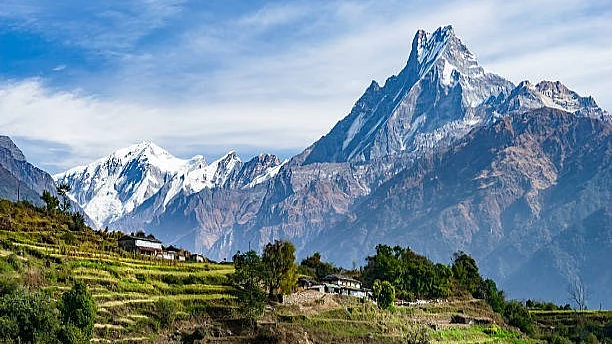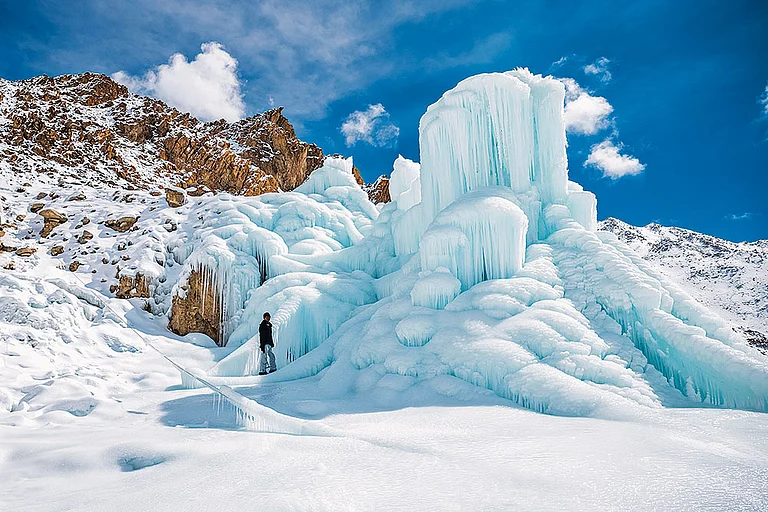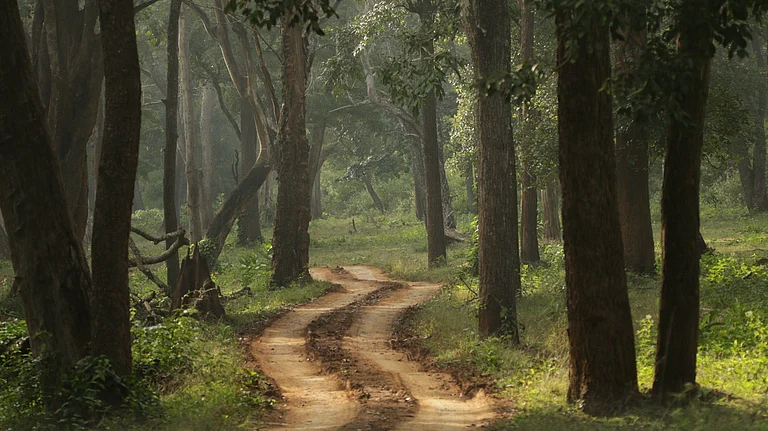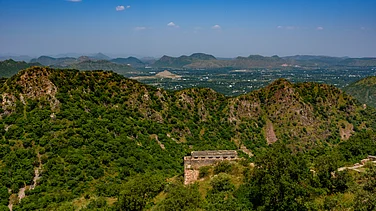
The Himalayas are young, restless mountains, their slopes held together by forests, wetlands and grasslands that act as nature’s shock absorbers.
Climate change is making storms more intense, glaciers less stable and disasters more frequent.
Unchecked construction, deforestation and hydropower tunnelling are dismantling the region’s natural defences.
Without urgent restoration and strict limits on development, the mountains that sustain hundreds of millions will become a conveyor belt of catastrophe.
High in northern India, where the land folds into the world’s youngest and tallest mountains, sprawls one of the most complex and fragile ecosystems on Earth. The Himalayas are not just a line of peaks etched against the sky; they are a living, shifting system — home to unique forests, deep river valleys, glaciers, and some of the most densely populated mountain landscapes in the world. For centuries, people have drawn life from these slopes, grazing livestock on salubrious meadows, terracing hillsides for grain, and tapping spring water to feed orchards and homes. But this glorious natural filigree that sustains life is fraying, and Uttarkashi shows how swiftly it can unravel into catastrophe.
The Himalayas were born from a geological collision — the Indian tectonic plate driving into the Eurasian plate about 50 million years ago. This head-on impact forced up the tallest mountains in the world, and the process has never stopped. The range still rises about five millimetres a year. That youth is part of its problem. Unlike ancient, weather-worn mountains such as the Appalachians, the Himalayas are geologically unstable. Slopes are steep, rock is fractured, and landslides are a natural part of the landscape.
Forests, meadows, and thick root systems help stabilise these slopes, binding soil and absorbing the heavy monsoon rains that sweep in each summer. Strip away that vegetation, and the underlying geology is quick to crumble. Rainwater runs off faster, rivers rise more abruptly, and the smallest tremor or cloudburst can unleash massive landslides or flash floods.
The Water Towers of Asia
The Himalayas are often called the “Water Towers of Asia.” They feed ten of the continent’s great rivers — the Ganga, Brahmaputra, Indus, Mekong, Yangtze, and others — which in turn sustain hundreds of millions of people downstream. Snowfields and glaciers act as natural reservoirs, releasing water slowly through the year. Forests and alpine wetlands help regulate this flow, soaking up rain and meltwater, then releasing it gradually.
Disturbing these systems doesn’t just affect high-altitude villages; it reverberates far beyond. Deforestation, dam construction, and slope cutting alter the hydrology of entire river basins. Rivers begin to flow more violently in the wet season, bringing down more sediment and destabilising channels. In the dry months, water shortages become more acute because the natural storage capacity of the ecosystem has been diminished.
Add climate change to the equation, and the risks snowball. In the central Himalayas, India’s Meteorological Department has recorded a more than 50% increase in “very heavy” rainfall events over the past two decades. Warmer air holds more moisture, making monsoon bursts more intense. At the same time, glaciers are retreating at alarming rates, which increases meltwater in the short term but threatens long-term water security.
Warmer temperatures are also thawing permafrost, the frozen ground that binds rocks together at high altitudes. As it melts, slopes lose cohesion, triggering more frequent landslides. When extreme rainfall hits a deforested slope above a river, the results can be deadly — a sudden wall of water, mud, and debris surging downstream, sweeping away everything in its path.
An Overloaded Landscape
While the Himalayas have always been a challenging place to live, human pressure has grown enormously in recent decades. Uttarakhand’s population has nearly doubled since 1981, and the region now sees countless tourists each year. Roads are widened, riverbanks cleared for hotels, and forests cut to make way for hydropower projects. This kind of development may bring short-term economic gains, but it overloads the natural systems that keep the mountains stable.
Every time a slope is cut for a road, the risk of landslide increases. Every riverside construction project narrows the floodplain, forcing water into faster, more destructive channels. Tourism brings income, but it also generates waste, strains water supplies, and often encourages illegal construction in high-risk zones.
The Domino Effect of Deforestation
Deforestation is one of the most damaging interventions in the Himalayan ecosystem. Forests act like sponges, intercepting rainfall and letting it seep slowly into the ground. Their roots anchor soil and reduce erosion. When these trees are removed — whether for timber, agriculture, roads, or resorts — the sponge is gone. Rain falls directly onto bare soil, which washes away, carrying nutrients and sediment into rivers. This siltation not only harms aquatic life but also clogs reservoirs, reducing their storage capacity and increasing the risk of floods downstream.
In many parts of the Himalayas, including Uttarkashi, deforestation is compounded by monoculture plantations used for so-called “compensatory afforestation.” These plantations often lack the biodiversity and root structure of natural forests, offering little of the same ecological protection.
Hydropower: Clean Energy, Dirty Impact
Hydropower projects are often promoted as a clean alternative to fossil fuels, but in the Himalayas they come at a steep ecological price. Dams and diversion tunnels require extensive blasting, which weakens already fragile slopes. Reservoirs flood forests and agricultural land, and the sudden release of water during power generation can alter river ecosystems downstream.
In valleys like the Bhagirathi and Alaknanda, multiple projects are packed into short stretches of river. The cumulative impact is severe: destabilised slopes, altered sediment flows, and the loss of riparian vegetation. When disasters strike in such altered landscapes, their scale and speed are amplified.
The fragility of the Himalayan ecosystem is not just about geology or climate. It is about the loss of buffers — the forests, wetlands, grasslands, and floodplains that absorb shocks and slow destructive forces. Remove those buffers, and the chain reaction from a single event, like a cloudburst, can be catastrophic.
In a healthy watershed, heavy rain might trigger small landslides and cause rivers to swell gradually. In a degraded watershed, the same rain can send torrents of water, boulders, and debris hurtling down valleys in minutes, with no warning and no chance for people to escape.
The Path to Resilience
Scientists and conservationists agree that protecting the Himalayan ecosystem requires a multi-layered approach. It begins with halting deforestation in ecologically sensitive zones and restoring degraded forests with native species, not monoculture plantations. Equally critical is the strict enforcement of building codes and land-use regulations to keep infrastructure out of high-risk floodplains and unstable slopes. Climate projections must be integrated into every development plan, with the recognition that areas considered safe a decade ago may now face heightened risk. And at the heart of any lasting solution lies the participation of local communities. Mountain residents often carry generations of knowledge about living within the limits of their environment, and their voices are essential for building resilience that endures.
The Uttarkashi flash flood is the latest in a series of Himalayan disasters — Kedarnath in 2013, Chamoli in 2021, Wayanad in 2024 — each one leaving behind a trail of destruction, each one blamed in part on the same systemic failures. The mountains have been speaking in the language of rivers and landslides, but the message is always the same: there are limits, and we are crossing them.
The Himalayas will always be dynamic, unpredictable, and at times dangerous. But their fragility is not a death sentence — unless it is ignored. If their natural defences are protected and restored, these mountains can continue to sustain life for millions. If they are dismantled in the name of unchecked growth, the disasters we call “natural” will become both more frequent and more deadly.





























